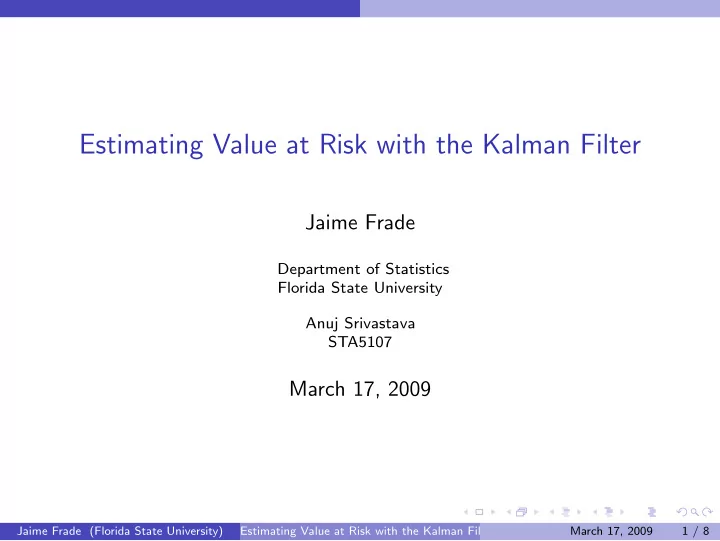

Estimating Value at Risk with the Kalman Filter Jaime Frade Department of Statistics Florida State University Anuj Srivastava STA5107 March 17, 2009 Jaime Frade (Florida State University) Estimating Value at Risk with the Kalman Filter March 17, 2009 1 / 8
Outline Objective 1 Data of Model 2 Kalman Filter Process 3 Results: VaR: Calculations 4 Plot VaR: 5 Plots of Error: 6 Jaime Frade (Florida State University) Estimating Value at Risk with the Kalman Filter March 17, 2009 2 / 8
Objective Goal In this project, the goal is to apply one technique of risk management which measures as a percent the maximum loss which is likely to be exceeded on the portfolio, given a certain probability and time horizon within a given confidence level under assumed market conditions. Using Value-at-Risk, VaR, will estimate the β ’s of the assets of the portfolio with a Kalman Filter. Overall, the results showed more market sensitivity compared to historical simulation, depending on the assets of the portfolio or on the type of fund itself, for instance a hedge fund. Jaime Frade (Florida State University) Estimating Value at Risk with the Kalman Filter March 17, 2009 3 / 8
Data of Model Time horizon: (01/02/2004- 3/12/2009). Daily Stock last trade price for two individual companies, GE and IBM. S&P as my market variable. n = 1306 observations. Jaime Frade (Florida State University) Estimating Value at Risk with the Kalman Filter March 17, 2009 4 / 8
Kalman Filter Process Figure: Kalman Filter Process Jaime Frade (Florida State University) Estimating Value at Risk with the Kalman Filter March 17, 2009 5 / 8
Results: VaR: Calculations Procedure VaR Historical Simulation loss of 2 . 32% Kalman Filter loss of 2 . 74% Intrepretation: With 95% confidence, we expect that the worst daily loss will not exceed given percentage Jaime Frade (Florida State University) Estimating Value at Risk with the Kalman Filter March 17, 2009 6 / 8
Plot VaR: � √ w ′ ββ ′ w σ 2 VaR = z ∆ t (1) m Plot of daily VaR calculations based on porfolios of equal weights. Figure: Sequence of VaR Calculations Jaime Frade (Florida State University) Estimating Value at Risk with the Kalman Filter March 17, 2009 7 / 8
Plots of Error: Plots of a comparsion of between using the predicted X ( t +1) P and X ( t +1) P − ADJ to predict the R ( t +1) P (= Y ( t +1) P ) Figure: Relizations of Error Plots Jaime Frade (Florida State University) Estimating Value at Risk with the Kalman Filter March 17, 2009 8 / 8
Recommend
More recommend